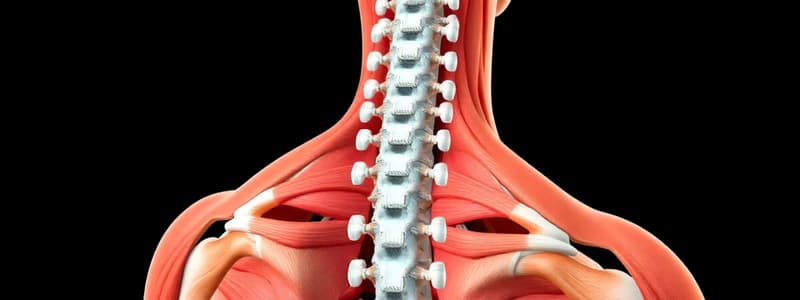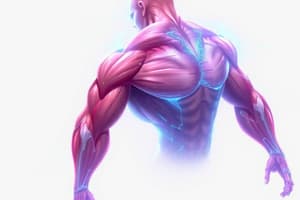Podcast
Questions and Answers
Which technique enhances muscle activation by resisting motion?
Which technique enhances muscle activation by resisting motion?
- Approximation
- Traction
- Quick stretch
- Manual contact (correct)
What is the main goal of approximation in treatment?
What is the main goal of approximation in treatment?
- Inhibition
- Compensation
- Facilitation (correct)
- Traction
Which technique is used to improve muscle firing through repeated contractions?
Which technique is used to improve muscle firing through repeated contractions?
- Slow reversal
- Quick stretch (correct)
- Alternating isometrics
- Rhythmic stabilization
What is a key component to acquire increased active and passive ROM after isometric holds?
What is a key component to acquire increased active and passive ROM after isometric holds?
Which type of cuing involves altering tone according to the goal?
Which type of cuing involves altering tone according to the goal?
Which technique for controlled mobility involves reversing the direction of antagonists?
Which technique for controlled mobility involves reversing the direction of antagonists?
How should manual contact be applied to enhance muscle performance?
How should manual contact be applied to enhance muscle performance?
Which approach improves balance and stability by using resistance from proximal to distal?
Which approach improves balance and stability by using resistance from proximal to distal?
What is the primary function of mobilizers in muscle function classification?
What is the primary function of mobilizers in muscle function classification?
Which muscle is classified as a stabilizer in the cervical spine region?
Which muscle is classified as a stabilizer in the cervical spine region?
What is the characteristic activity type of local stabilizers?
What is the characteristic activity type of local stabilizers?
Which of the following descriptions best fits global stabilizers?
Which of the following descriptions best fits global stabilizers?
What is the progression method in stabilization training for trunk muscles?
What is the progression method in stabilization training for trunk muscles?
In the stabilization classification, what is the role of the Transversus abdominis?
In the stabilization classification, what is the role of the Transversus abdominis?
Which muscle would be least associated with shock absorption?
Which muscle would be least associated with shock absorption?
What is the purpose of using varied environments in stability training?
What is the purpose of using varied environments in stability training?
Which training method involves using external tape and bracing?
Which training method involves using external tape and bracing?
What type of muscle contractions are a focus under 'MAINTAIN' in stability training?
What type of muscle contractions are a focus under 'MAINTAIN' in stability training?
What is a hallmark feature of proprioceptive neuromuscular facilitation (PNF)?
What is a hallmark feature of proprioceptive neuromuscular facilitation (PNF)?
Which concept does not belong to the general movement concepts listed?
Which concept does not belong to the general movement concepts listed?
What type of stimulus is most associated with proprioceptive neuromuscular facilitation for promoting neuromuscular response?
What type of stimulus is most associated with proprioceptive neuromuscular facilitation for promoting neuromuscular response?
What is emphasized in 'SUSTAIN' phase of stability training?
What is emphasized in 'SUSTAIN' phase of stability training?
What does PNF aim to address through its manual methods?
What does PNF aim to address through its manual methods?
Which pattern reflects the natural coordination of diagonal movements with spiral components?
Which pattern reflects the natural coordination of diagonal movements with spiral components?
Flashcards
Stabilization
Stabilization
The process of maintaining joint alignment through controlled tension.
Mobilizers
Mobilizers
Muscles that generate movement and torque; associated with dynamic activities.
Stabilizers
Stabilizers
Muscles that maintain joint stability with minimal length change, acting isometrically.
Spinal Mobilizers
Spinal Mobilizers
Signup and view all the flashcards
Spinal Stabilizers
Spinal Stabilizers
Signup and view all the flashcards
Stabilization Progression
Stabilization Progression
Signup and view all the flashcards
Stability Training
Stability Training
Signup and view all the flashcards
Dynamic Equilibrium
Dynamic Equilibrium
Signup and view all the flashcards
ATTAIN
ATTAIN
Signup and view all the flashcards
Isometric Muscle Contractions
Isometric Muscle Contractions
Signup and view all the flashcards
PNF (Proprioceptive Neuromuscular Facilitation)
PNF (Proprioceptive Neuromuscular Facilitation)
Signup and view all the flashcards
Diagonals of Movement
Diagonals of Movement
Signup and view all the flashcards
Co-contractions
Co-contractions
Signup and view all the flashcards
Impaired Mobility Indicators
Impaired Mobility Indicators
Signup and view all the flashcards
Endurance
Endurance
Signup and view all the flashcards
Manual Contacts
Manual Contacts
Signup and view all the flashcards
Visual Cuing
Visual Cuing
Signup and view all the flashcards
Manual Contact and Resistance
Manual Contact and Resistance
Signup and view all the flashcards
Approximation and Traction
Approximation and Traction
Signup and view all the flashcards
Quick Stretch Technique
Quick Stretch Technique
Signup and view all the flashcards
Rhythmic Initiation
Rhythmic Initiation
Signup and view all the flashcards
Stability Techniques
Stability Techniques
Signup and view all the flashcards
Rhythmic Stabilization
Rhythmic Stabilization
Signup and view all the flashcards
Study Notes
Stabilization
- Advanced motions and engagement
Functional Classification of Muscles
- Mobilizers – Global – Phasic
- Generates torque – movement producer
- Concentric power
- Shock absorption
- Stabilizers – Local – Tonic
- Tension to control joint alignment
- Minimal length change – isometric
- Continuous activity with movement
- High kinematic input
- Stabilizer – Global – mix
Function Classification with Spinal Muscles (Pg. 423)
- Mobilizers – Global – Phasic
- Lumbar spine
- Rectus abdominis
- External/internal obliques
- QL
- Erector spinae
- Iliopsoas
- Cervical spine
- SCM
- Scalenes
- Levator
- Upper trap
- Erector spinae
- Lumbar spine
- Stabilizers – Local – Tonic
- Lumbar spine
- Transversus abdominis
- Multifidus
- QL – deep portion
- Cervical spine
- Rectus capitis anterior and lateralis
- Longus colli
- Lumbar spine
Stabilization Progression – for trunk
- Through more challenging posture or environment (for example)
- Sitting to standing to standing on one leg
- Firm surface to compliance surface to moving surface
- Single plane to multiple planes
- Through action in that posture or environment
- Attain
- Maintain
- Sustain
Stability Training
- Dynamic exercises within an equilibrium
- ATTAIN:
- Joint positioning
- Postural Training
- External tape and bracing
- Internal muscle bracing and holding
- Isometric muscle contractions
- Endurance
- MAINTAIN:
- Midrange motions
- Co-contractions
- Eccentric antagonist contractions
- SUSTAIN:
- Outside base of support
- External perturbation
- Closed kinetic chain
- Open kinetic chain
- Emphasize ballistic forces
- Emphasize random forces
General Movement Concepts – PNF
- Mobility
- Stability
- Controlled Mobility
- Skill
Proprioceptive Neuromuscular Facilitation (PNF)
- Manual methods of promoting the response of neuromuscular systems
- Methods are employed for altered or inefficient patterns of motion or posture
PNF (Ch 6; pgs. 215-223)
- Developed by physical therapists
- PNF use external stimuli to augment motor response
- Tactile
- Proprioceptive
- Visual
- Auditory
Patterns of Facilitation (p 215)
- "the stronger muscle groups of a diagonal pattern facilitate the responsiveness of the weaker muscle groups"
Diagonals of Movement
- Innate path in which maximal response of the trunk and extremities can be facilitated
- Head & neck, upper & lower trunk, upper and lower extremities
- "Normal coordinated patterns of motion are diagonal in direction with spiral components – facilitate strongest output"
- Reflects functional relationship of trunk and extremities
Movement Requirements
- Mobility
- Stability
- Controlled Mobility
- Skill
Indications for PNF
- Impaired mobility
- Impaired muscle performance
- Impaired endurance
- Impaired balance/stability
- Impaired posture
- Pain impairments
Body Positioning and Mechanics
- Stand in the diagonal plane whenever possible
- Forearms will move within the plane
- Manual contacts: Maximize to decrease pressure, specific to direction
Verbal and Visual Cuing
- Clear and concise
- Begin by providing information about full response
- Change to more simple cues for subsequent repetitions
- Alter tone according to goal
- Have patient follow motion with eyes
Manual Contact and Maximal Resistance
- Resistance to motion enhances muscle activation
- Manual contact always on the muscle contracting
- The direction, quality, and quantity of resistance are adjusted according to treatment goals
- Resistance should allow full ROM
Approximation and Traction
- Enhance muscle performance prior to treatment
- Traction – inhibition
- Approximation – facilitation
Stretch and Timing
- Quick stretch (used in repeated contraction) enhances muscle firing
- Timing of firing through cues and amount of resistance for coordinated movement
Techniques of Facilitation
- Techniques for Mobility
- Rhythmic initiation
- Rhythmic rotation
- Repeated contractions
- Hold and relax (prior lab)
- Contract and relax (prior lab)
- Techniques for Controlled Mobility
- Reversals of antagonists
- Slow reversal
- Slow reversal holds
- Dynamic reversals of antagonists
- Quick reversals
- Techniques for Stability
- Alternating isometrics
- Rhythmic stabilization
Stability – 1. Isometric Holds
- Resist antagonists in a predictable pattern; don't release pressure until opposite direction is contacted
- Improve strength of antagonists
- Improve balance of antagonists
- Improve stability
- Increase active and passive ROM following technique
- Decrease pain
Stability – 2. Rhythmic Stabilization
- Resist from proximal to distal segments, alternate in unpredictable pattern or rotation (co-contraction)
- Improve balance and stability
- Improve strength
- Integrate a new posture or ROM into function
Controlled Mobility – 1. Reversals of Antagonists
- Mid-range motions
- Slow Reversal; Slow reversal / hold (to facilitate agonist)
- Improve balance between agonist and antagonist
Controlled Mobility – 2. Dynamic Reversals of Antagonists
- (Two movements – opposite directions)
- Improve strength in the available ROM
- Improve balance and coordination of antagonist
- Improve endurance of antagonistic patterns
Summary
- PNF is a manual therapy approach to therapeutic exercise
- Treatment is based on improving motions that are used for functional activities
- PNF techniques are appropriate for different types of impairments
Summary (Stabilization)
- Regional - check joints above and below
- Progressive development
- Attaining - just holding any position
- Closed chain or open chain
- Maintain – internal perturbations
- Sustain - external perturbations
- Person controls position against external forces or movement outside of base of support
Studying That Suits You
Use AI to generate personalized quizzes and flashcards to suit your learning preferences.



